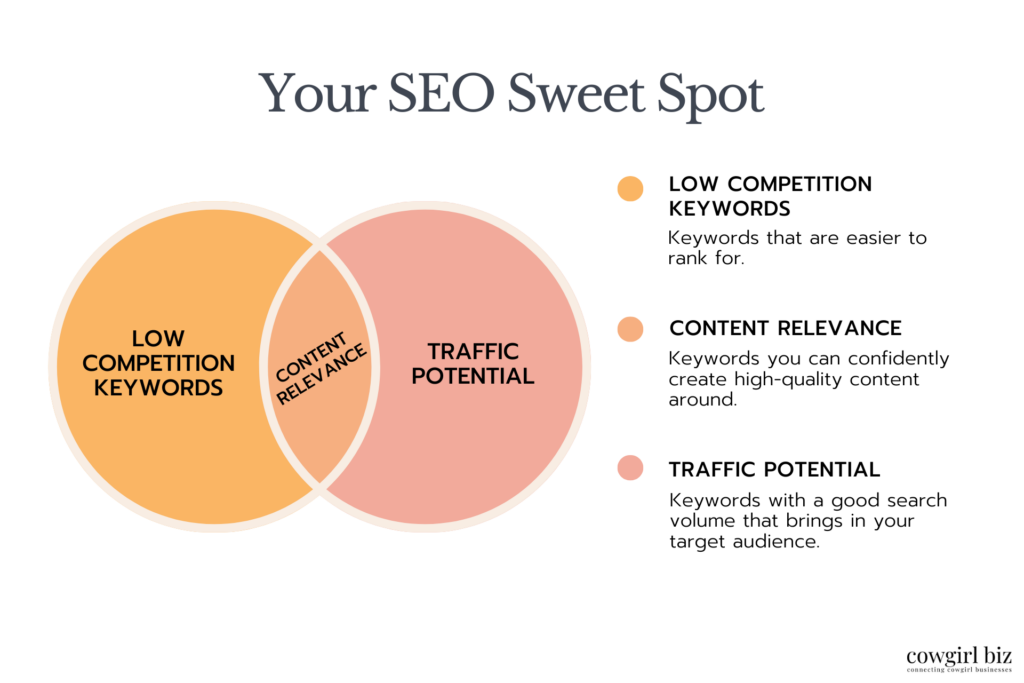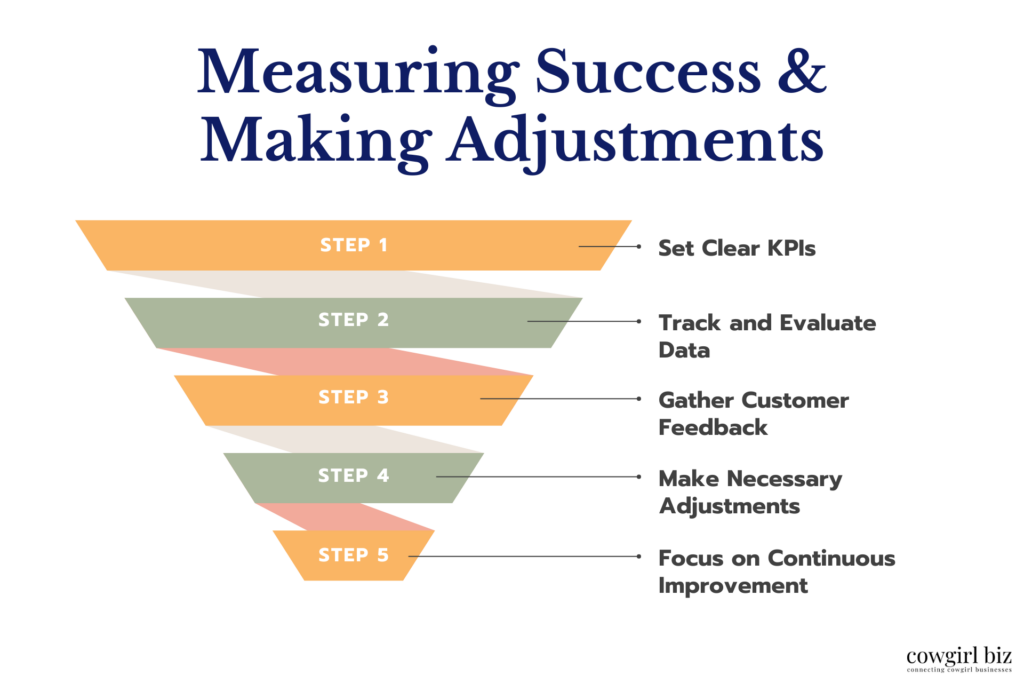
Getting your cowgirl business noticed can feel like wrangling wild horses—hard to control and even harder to steer in the right direction! That’s where SEO rides in, like a trusty trail guide, leading the right folks straight to your door. Think of it as your secret weapon for attracting organic traffic, building a strong brand reputation, and reaching people who truly appreciate what you’re all about.
Here are five simple yet powerful SEO strategies tailored just for cowgirl entrepreneurs—no tech jargon, just practical steps you can saddle up and start today.
1. Know Your Keywords Like the Back of Your Saddle
Finding the right keywords for your business is like knowing the best trails—they lead the right folks straight to you. Keywords connect your content to what people are searching for, but it’s about choosing good ones: terms that bring in traffic without facing too much competition.
Why Keyword Research Matters
Think of keyword research as a bit of detective work. You’re looking for high-traffic terms that relate to your products and aren’t too crowded with competition. Tools like Google Keyword Planner and Ahrefs can help by showing you search volume, competition levels, and even what keywords your competitors are using.
Look for long-tail keywords (phrases with three or more words) that are specific to your niche—they may bring in less traffic, but they attract visitors ready to buy.

How to Find the Right Keywords
Now, let’s saddle up and start searching for those keywords that resonate with your audience.
Identify Niche Keywords
Use tools like Google Keyword Planner, Ahrefs, or Ubersuggest to explore low-competition keywords tied to Western culture, the cowgirl lifestyle, and unique products. These tools are like your search partners, giving you insights into terms that might be less obvious but perfectly tailored to your brand.
For example, instead of broad terms like “leather bags,” think about niche terms like “handmade cowgirl leather bags” or “vintage Western accessories.”
Cowgirl-Specific Phrases
Consider keywords that truly capture the essence of the cowgirl lifestyle. Words and phrases that feel right at home in your niche might include:
“cowgirl leather goods”
“Western-style home decor”
“handcrafted cowgirl boots”
“rustic cowgirl jewelry”
These phrases are not only less competitive but also more likely to connect with your ideal customers who are looking for something special in the Western style.
Pro Tip: Here’s a trick that’s as simple as it is powerful. Go to Google, start typing a phrase related to your product, and see what Google suggests in the autocomplete dropdown.
These suggestions are real searches that people are typing in, so they’re a great source for finding long-tail keywords that reflect what folks are truly searching for.
For example, if you type “cowgirl boots for…” you might see suggestions like “cowgirl boots for weddings” or “cowgirl boots for country concerts.” These phrases not only give you more specific ideas but also help you align your content with search intent.
2. Optimize Your Website: Giddy-Up for On-Page SEO
Let’s make your website as inviting as a well-set ranch. With a few key tweaks, you’ll be ready to guide folks right to the content they’re searching for.
Title Tags and Meta Descriptions
Think of title tags and meta descriptions as the signs outside your storefront. They’re the first things people see in search results, and they can make all the difference in whether someone decides to visit your site. A well-written title and description help increase click-through rates (CTR), signaling to Google that people find your content valuable. Sites with higher CTRs often see improved rankings.
- Keep it Short and Sweet: Google usually displays only the first 50-60 characters of a title tag and around 155 characters for meta descriptions. Make every word count.
- Add Keywords Naturally: Include keywords relevant to your content, like “cowgirl leather boots” or “handcrafted Western decor.” But don’t overdo it—write for real people, not just search engines.
- Make it Inviting: Titles and descriptions should entice the reader. Try phrasing them in a way that addresses their needs, like “Discover Unique Cowgirl Jewelry” or “Shop Authentic Western Home Decor.”
Content Structure and Headers
Imagine your content as a trail map—structured headers make it easy for readers (and search engines) to navigate. Break up your content with headers (H1, H2, H3) so folks can quickly skim and find what they’re looking for.
According to a study by the Nielsen Norman Group, people spend only 20% of their time on a webpage actually reading; the rest is spent skimming. Organized content encourages them to stay longer, improving engagement and helping with SEO.
- Use One H1 Tag per Page: The H1 tag should clearly tell readers what the page is about, like a newspaper headline.
- Break Up Long Text: Use H2s and H3s for subheadings to add structure and highlight key points. This is especially helpful for product descriptions or longer blog posts.
- Make It Scannable: Bullet points, numbered lists, and short paragraphs keep your content easy on the eyes.
Image Optimization
Images add beauty and character to your site, but if optimized properly, they can also boost your SEO. Adding alt text (a description of the image) is important for accessibility and helps Google understand what’s in the image.
For example, instead of naming an image “IMG1234.jpg,” try “handcrafted-leather-cowgirl-boots.jpg.” This way, people searching for cowgirl boots can find your site through image searches.
Internal Linking
Internal links are like handy maps that guide visitors to more of your content. Linking to other pages on your site not only keeps readers exploring (increasing time spent on the site) but also helps Google understand the structure of your website.
The more interconnected your pages are, the easier it is for search engines to see which pages are most important.
If you’re writing about cowgirl boots, link to your product pages or other blog posts about styling Western wear. This creates a natural flow for readers and encourages them to keep exploring.
Link to pages that genuinely relate to the current content. This keeps the flow natural and enhances the reader’s experience.
3. Round Up Local Cowgirl Fans with Local SEO
For cowgirl businesses with physical shops or local services, local SEO is key to getting noticed by nearby customers. When folks search for products or services in your area, local SEO helps your business pop up, making it easy for locals to find you.
Google Business Profile
Creating a Google Business profile is like putting up a big welcome sign. Make sure to add accurate business details and quality photos and update it regularly. This way, potential customers can see what you offer right at a glance.
Customer Reviews: Reviews add trust. Encourage happy customers to leave a review by offering a gentle reminder in follow-up emails or at checkout. Positive reviews boost your local ranking and make new customers more likely to visit.
Localized Content Ideas
Add blog posts that cater to local searches, like “Best Cowgirl Shops in [Your City]” or “Western Style Events Near [Your Location].” Localized content helps attract nearby visitors searching for specific Western products or events in their area.
Directory Listings
Get your business listed in local directories, especially ones that focus on Western or cowgirl businesses like Cowgirl Biz. Each listing not only boosts visibility but also adds backlinks, helping your SEO overall.
4. Content is Queen: Share What Speaks to Your Cowgirl Community
Creating content that speaks to your cowgirl community means knowing their interests, from style needs to unique values.
When you understand what they care about, you can share content that truly resonates, like educational blogs (“How to Style Western Outfits”), product guides (“Top 5 Must-Have Cowgirl Boots”), or behind-the-scenes stories that reveal the heart of your brand.
Weave keywords naturally into posts, product pages, and captions and mix in multimedia like videos or images to keep things lively and engaging.
5. Building Links the Cowgirl Way: Backlink Strategies
Backlinks are like a tip of the hat from other websites—they show Google that your site is trustworthy. Here’s how to rope in quality links:
- Partner with Like-Minded Brands: Team up with Western or lifestyle brands for guest blogs or content swaps, helping each other grow.
- Get Featured on Cowgirl Blogs: Reach out to influencers or blogs that love the Cowgirl lifestyle and see if they’ll feature your brand.
- Create Shareable Content: Create fun, link-worthy pieces, like a “Cowgirl’s Guide to Styling,” that others will want to share.
And don’t forget to use Ahrefs or Google Search Console to track those links and keep your site’s authority strong.


